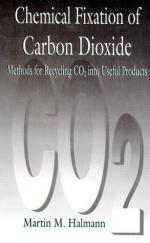|
This section contains 430 words (approx. 2 pages at 300 words per page) |

|
Carbon fixation refers to the chemical transformation of simple, inorganic compounds of carbon into more complex forms of organic matter. Examples of the simple compounds include carbon dioxide (CO2) and bicarbonate (HCO3 -), while the more complex forms include calcite (CaCO 3), which is inorganic, and the organic matter of organisms.
In ecosystems, carbon is fixed by autotrophs—organisms that utilize an external energy source to drive the synthesis of CO2 and water (H2O) into simple sugars. Usually, sunlight is the energy source for the fixation reactions, which is referred to as photosynthesis, and the organisms as photoautotrophs. Examples of photoautotrophs include plants, algae, and blue-green algae. Expressed simply, the photosynthetic reaction is:
(1) CO2 + 2H2O light CH 2O + 2O2 + H2O.
In reaction 1, the term CH2O refers to a carbohydrate, which is a primary product of photosynthesis. The molecular oxygen (O 2) is a...
|
This section contains 430 words (approx. 2 pages at 300 words per page) |

|


